Physical Address
304 North Cardinal St.
Dorchester Center, MA 02124
Recognizing a pattern of disease is critical in surgical and autopsy neuropathology, especially for infectious diseases. However, few other central nervous system (CNS) diseases rival infections in their requirement for a multimodal approach—combining clinical, laboratory, and pathology information—in order to arrive at a precise diagnosis.
Clinical information that narrows the differential diagnosis for any putative CNS infection includes patient age, geographic distribution, tempo of disease onset and progression, any antecedent history of trauma or surgery, immune status, exposures, and mode of acquisition. Pathogenic infections occur in any host that is exposed to a sufficient number of infectious organisms in their environment, either at home, during recreation, or when traveling. Opportunistic infections occur in hosts who are immunosuppressed (acquired immunodeficiency syndrome [AIDS], transplant recipients, neutropenic patients, patients treated with corticosteroids or other immunomodulatory drugs, fetuses, and neonates), which makes them susceptible to infection with atypical organisms that would otherwise not cause disease. Community-acquired infections occur in the course of normal daily living, whereas nosocomial infections are acquired while being treated in a hospital.
Tempo of disease is critical, with acute infections more commonly due to virulent organisms such as bacteria and viruses, while subacute/chronic infections are often attributable to indolent bacteria (i.e., mycobacteria), fungi, or parasites. Any features discovered by the pathologist on histologic studies must always be correlated with laboratory findings including serology, cultures, and any intraoperative stains. After placing clinical and laboratory findings in the context of histologic features, the pathologist can more selectively choose from a limited repertoire of culture(s), polymerase chain reaction (PCR)–based assays, and appropriate histochemical and immunohistochemical stains to define the precise organism responsible for infection.
Pattern recognition of infections at the tissue level begins with determining which CNS compartment is affected. The most frequently involved compartments include the extra-axial (epidural, subdural, leptomeningeal) spaces and the parenchyma (e.g., cerebritis, abscess). Histologic alterations are then defined as being diffuse or discrete. Diffuse meningeal involvement (meningitis) occurs with infection by bacteria, mycobacteria, viruses, fungi, and occasionally parasites. Diffuse parenchymal inflammation of the brain, known as encephalitis, or of both meninges and brain (meningoencephalitis), is most often caused by viruses or parasites. Encephalitis is defined by the presence of perivascular lymphocytes, microligal nodules, and varying degrees of neuronal loss and gliosis, although these features vary with the viral type and the immune status of the host. Encephalitis can be further classified as diffuse versus focal, with the latter including specific involvement of certain portions of the neuraxis, such as temporal lobe encephalitis, brainstem encephalitis (with rhomboencephalitis referring to involvement of the medulla), spinal cord inflammation (myelitis), ganglion inflammation (ganglionitis), and proximal nerve root inflammation (radiculitis). Discrete infectious processes surrounded by a capsule are typically confined to one intracranial compartment and are most often suppurative, with acute inflammation, and are most often bacterial in origin (e.g., brain abscess, epidural abscess, subdural empyema).
Because of the emphasis on recognizing disease patterns, this chapter will illustrate major categories of CNS infections rather than catalog microscopic morphology of specific organisms themselves. Tables provide details regarding demographic, geographic, and tissue patterns of involvement, as well as laboratory testing, for the most common organisms that can infect the nervous system. The final section will address inflammatory conditions that can mimic infections and neoplasms, such as neurosarcoidosis and nervous system manifestations of collagen vascular disorders.
Meningitis is defined as inflammation of the membranes of the brain or spinal cord, specifically the subarachnoid space, and is characterized by cellular infiltrates within its confines. For infectious meningitis, the cellular infiltrates within the subarachnoid space are, by definition, inflammatory hematopoietic cells. Although the term meningitis evokes a “frosting-monolayer” image of surface exudates in the minds of most clinicians, it should be remembered that the subarachnoid space dips down between sulci and extends into brain parenchyma along Virchow-Robin spaces. The latter extend along arteries, arterioles, veins, and venules deep into the CNS. Hence, inflammatory infiltrates of meningitis have ample opportunity to interact with adjacent areas of brain and spinal cord.
Bacterial meningitis, sometimes referred to as purulent meningitis, is characterized by thick, creamy, neutrophil and protein-rich, leptomeningeal exudate especially in severe fatal cases. Aseptic meningitis is a broad term that includes all types of meningitis associated with negative bacterial cultures and that can be caused by viral, fungal, parasitic, rickettsial, postinfectious, drug-related, and collagen vascular diseases. In practice, however, most aseptic meningitis is viral.
Acute bacterial meningitis is the most common form of suppurative CNS infection, with an annual incidence in the United States of more than 2.5 cases/100,000 population. The epidemiology has changed in recent years due to the dramatic declines in incidence of Haemophilus influenzae, Streptococcus pneumonia, and Neisseria meningitidis infections following the introduction and widespread use of vaccines against these organisms. In contrast, there has been emergence of penicillin/cephalosporin-resistant S. pneumoniae, and pneumococcal meningitis remains the most common cause of meningitis in adults older than 20 years of age, accounting for over half of all reported cases and totaling 1.1 cases per 100,000 persons per year. The median age of patients with meningitis is now 30.3 years, compared with approximately 1 year in 1986.
Organism type varies with patient age, underlying risk factors, community-acquired versus nosocomial disease, and patient immune status. Certain types of bacteria are more likely to cause meningitis in specific settings: (1) gram-negative Staphylococcus aureus, Staphylococcus epidermidis, streptococci, and N. meningitidis (“meningococcus”) are most frequently associated with head trauma/neurosurgery/nosocomial meningitis; (2) N. meningitidis is most frequently associated with fulminant onset disease, epidemics, purpural/petechial rash, asplenia, or complement deficiency states; (3) S. pneumoniae (“pneumococcus”) is most commonly associated with pneumonia, otitis, sinusitis [access routes to the CNS for the most common bacterial meningitis in adults], or head trauma, alcoholism, cirrhosis, asplenia, sickle cell disease/thalassemia, multiple myeloma, humoral immunodeficiency, or cerebrospinal fluid (CSF) leakage (e.g., basilar skull fracture).
Patients at greatest risk for meningitis due to Listeria monocytogenes include neonates younger than 1 month of age, pregnant women, adults older than 60 years, and immunocompromised individuals of all ages. Infection is acquired by ingesting foods contaminated by Listeria, most often coleslaw, milk, soft cheeses, delicatessen meat, and undercooked hotdogs. A notable multistate outbreak of Listeria in the United States occurred in 2011, originating from a single farm in Colorado producing cantaloupe and traced to unsanitary conditions in the processing of raw produce. It resulted in 147 infections, leading to 99% of patients being hospitalized and 22% of resultant deaths. While most culture isolates came from blood (84%), the second most frequent culture site was cerebrospinal fluid (5%), reflecting the meningitis in these patients. In contrast with foodborne infections, the organisms responsible for bacterial meningitis acquired in a community setting in the general adult population include S. pneumoniae (50%), N. meningitides (25%), group B streptococci (15%), L. monocytogenes (10%), and Haemophilus influenzae (<10%). The patient age distribution patterns for specific types of bacterial meningitis are detailed in Table 23.1 .
| Patient Age | |||
|---|---|---|---|
| Bacteria Type | Younger Than 1 Month (%) | 1 Month–29 Years (%) | Older Than 30 Years (%) |
| Haemophilus influenzae | 0–1 | <5 | 1–10 |
| Neisseria meningitides | 0–1 | 50–60 | 10–25 |
| Streptococcus pneumoniae | 0–5 | 25–30 | 50–70 |
| Staphylococcus aureus | 5 | 1–2 | Head trauma, neurosurgery, shunt |
| Listeria monocytogenes | 7 | 1–2 | 5–10 (≈25% if >60 years or decreased cell immunity) |
| Gram-negative bacilli | 30 | 1–2 | 1–10 Age > 50 or decreased cell immunity |
| Streptococci group B | 50 (Streptococcus agalactiae) | 2–4 | <5 |
The demographics of acute viral meningitis differ considerably from bacterial meningitis. Since viral meningitis is not a nationally reportable disease, the incidence can only be estimated at approximately 75,000 cases per year in the United States. In temperate climates, the peak incidence is during the summer and early fall months, largely due to the predominance of enteroviral and arthropod-borne (arbovirus) infections. At the height of the season, incidence may reach 1 case per 100,000 persons per month. Common, uncommon, and rare causes of acute viral meningitis are listed in Table 23.2 .
| Common | Intermediate or Uncommon | Rare |
|---|---|---|
| Enteroviruses | HSV 1 | Adenoviruses |
| Arboviruses | EBV | CMV |
| HSV-2 | VZV | Influenza A, B |
| WNV | HIV | LCMV |
| HHV-6 | Measles, mumps, rubella | |
| Parainfluenza | ||
| Rotavirus |
Arthropod-borne viruses, or arboviruses, are transmitted through the bites of mosquitoes, ticks, or sandflies. While there are numerous types throughout the world, West Nile virus (WNV) and dengue virus diseases are probably the most well known in North America, with St. Louis encephalitis, La Crosse, and eastern equine encephalitis virus diseases also being familiar to many clinicians. Recently, Jamestown Canyon, Powassan, chikungunya, and Zika viruses have emerged as increasingly important arboviruses that can cause human disease in North America. Jamestown Canyon virus was first identified in Jamestown Canyon, Colorado, in 1961, and may present as a nonspecific febrile illness, meningitis, or meningoencephalitis. The infection may be underrecognized, in part because of cross reactivity of the testing with La Crosse virus and also because 2013 was the first year the US Centers for Disease Control and Prevention (CDC) implemented routine Jamestown Canyon IgM antibody screening. Powassan infection predominates in the U.S. Great Lakes and Northeast regions and is usually asymptomatic, but can lead to a severe meningoencephalitis, which is fatal in approximately 10% of cases.
Prior to 2013, chikungunya virus disease outbreaks had been reported in Africa, islands in the Indian Ocean, India, and Southeast Asia; in late 2013, local chikungunya virus transmission was reported for the first time in the Western Hemisphere on the Caribbean island of Saint Martin, possibly imported by an infected traveler. From 2013 to 2015, chikungunya virus rapidly spread throughout 45 countries in tropical and subtropical North and South America. In the United States, local transmission has been documented in Florida, Puerto Rico, and the U.S. Virgin Islands. Infection with chikungunya virus is usually symptomatic, often causing a febrile illness with severe polyarthralgia (hence, the name chikungunya, meaning “that which bends” in the Makonde language of Tanzania). Deaths are rare, occurring in less than 1% of cases. Morbidity, however, can be significant as some have persistent polyarthralgias. Neurologic complications are not common, but there are reports of chikungunya virus infection associated with meningoencephalitis, myelitis, and Guillain-Barré syndrome.
By far the greatest impact on the public has been from Zika virus infections. Similar to the dengue viruses and chikungunya virus, Zika virus is a flavivius that is also transmitted by certain Aedes species of mosquitoes and propagates from humans to mosquitoes to humans during outbreaks. Zika virus infection has been associated with Guillain-Barré syndrome, microcephaly, and ophthalmologic birth defects.
Subacute or chronic tuberculous and fungal forms of meningitis are most commonly caused by Mycobacterium tuberculosis, Cryptococcus neoformans, and Coccidioides immitis. Less commonly subacute meningitis can be due to Treponema pallidum (syphilis) or Histoplasma capsulatum. Initial infection with M. tuberculosis, C. neoformans, and C. immitis occurs via a pulmonary route by inhalation of aerosolized material. Following primary lung infection of variable clinical severity, hematogenous distribution of TB or fungal organisms to the CNS occur. For tuberculosis, spread of organisms to the CNS occurs more frequently in children and immunocompromised patients, resulting in foci of millet seed–sized (miliary) tubercles in the parenchyma of the brain during the primary infection. These may remain quiescent for months to years before reactivation occurs. Tuberculous meningitis occurs if these reactivated caseous miliary foci lie adjacent to meninges and typically occurs in the basilar meninges.
Most fungal infections are acquired by inhalation of airborne fungal spores. Although many fungi occur worldwide, the dimorphic fungi that tend to cause CNS disease in patients are confined to specific geographic regions ( Table 23.3 ). C. neoformans is found worldwide in soil and bird excrement, but has the highest incidence of exposure in regions of the southeast and east coast of the United States. H. capsulatum is endemic to the Ohio and Mississippi river valleys due to the fungal predilection for moist soil from these areas. C. immitis is endemic to the desert regions of the southwestern United States, northern Mexico, and Argentina. The likelihood of various fungi causing pathogenic infections in immunocompetent hosts versus opportunistic infections in immunocompromised hosts is often specific to the individual organism. In descending order of frequency in immunocompetent hosts, the most common pathogenic fungi are Blastomyces dermatitidis > Histoplasma capsulatum > Coccidioides immitis > Cladosporium trichoides > Cryptococcus > Aspergillus > Fusarium > Rhizopus > Candida. CNS infections due to Candida species virtually always occur in immunocompromised hosts. The definition of immunocompromised host, however, goes well beyond human immunodeficiency virus (HIV)–infected patients and transplantation recipients. Many underlying risk factors that predispose to fungal infections (e.g., postoperative patients and patients with collagen vascular disorders, diabetes mellitus, pulmonary conditions, or trauma) can be encountered in community hospitals. Indeed, invasive fungal infections are increasingly encountered in the intensive care unit (ICU) setting, especially in non-neutropenic patients with predisposing conditions such as corticosteroid treatment, chronic obstructive pulmonary disease, liver cirrhosis, solid organ cancer, and transplantation in addition to HIV-infected patients. Most are related to invasive aspergillosis but mucormycosis infections are becoming increasingly prevalent, especially in patients with uncontrolled diabetes mellitus or in those with contaminated open wounds. Coassociated clinical features may include rapidly progressive necrotizing rhinosinusitis or infections in lungs, skin, or soft tissues.
| Almost All Fungi Occur Worldwide and Disease Is Worldwide in Distribution | Fungi With Geographic Predilection |
|---|---|
| Histoplasmosis | Coccidioidomycosis occurs in locations where rainfall is low and summer temperatures are high (southwestern United States, Mexico, Central America, parts of South America) |
| Chromoblastomycosis | |
| Cryptococcosis | |
| Pseudallescheriasis | |
| Candidiasis | |
| Aspergillosis | Blastomycosis and histoplasmosis in United States occur in river basins with moist soil (Ohio and Mississippi river valleys) |
| Zygomycoses |
Parasitic meningeal diseases are rare in the United States and are summarized in Table 23.4 .
| Parasite | Demographics of Most Frequent Types That Cause CNS Infections |
|---|---|
| Nematodes (metazoal infection by roundworm with wandering larvae/worms that can migrate to brain or eye) | Toxocara canis (visceral larval migrans and ocular/retinal infection) |
| Angiostrongylus cantonensis (rat lung worm), Asia, classically causes eosinophilic meningoencephalitis | |
| Strongyloides very rarely reported in patients with suppressed cell-mediated immunity | |
| Trematodes (metazoal infection by flat flukes with wandering egg layers that deposits eggs in CNS) | Schistosomiasis and paragonimiasis seen in Africa or Asia |
| Echinococcus granulosus (hydatid disease) brain cyst (3% patients) usually solitary, unilocular, cerebral hemispheres | |
| Cestodes (metazoal infection by tapeworms with wandering larvae that encyst in CNS) | Cysticercus cellulosae (neurocysticercosis) adult tapeworm Taenia solium causes asymptomatic or mildly symptomatic gastrointestinal disease; the larval stage infects multiple organs in humans, the most important being the CNS |
| Amebiasis protozoal infections | Naegleria fowleri Free-living waterborne ameba affecting previously healthy children and young adults esp. in summer and autumn months; swimming in warm lakes or pools. Protozoa enter CNS through nasal mucosa and cribriform plate |
| Granulomatous amebic encephalitis (Acanthamoeba/Balamuthia) causes disease in immunosuppressed patients or children | |
| Entamoeba histolytica Spread to brain via hematogenous route from liver or lung. CNS involvement rare; meningoencephalitis in 1%–2% of fatal cases | |
| Cerebral malaria protozoal infection | CNS involvement seen with only one species, Plasmodium falciparum |
| Mortality in some parts of the world 20%–50%, especially infants and children | |
| Well-nourished individuals more susceptible than malnourished ones in Africa: related to body iron status | |
| Infection common in pregnancy, possibly related to relative immunosuppression | |
| Steroid administration predisposes to severe infection: a touch of opportunistic infection | |
| Toxoplasmosis protozoal infection | Worldwide distribution; occurs following ingestion of oocysts shed in cat feces |
| Depending on geographic region, 3%–50% of population has antibodies | |
| Pathogenic infection frequent: infectious mononucleosis-like illness, febrile illness with maculopapular rash | |
| CNS involvement almost always an opportunistic infection; CNS involvement major complication of disseminated disease in AIDS and congenital cases | |
| Trypanosomiasis protozoal infection | South American trypanosomiasis |
| (Chagas disease) commonly involves autonomic nervous system, cause of the underlying megasyndromes. Protozoa have proclivity for infecting muscle | |
| CNS involvement uncommon | |
| Acute form of disease occurs in children younger than age 1 year; protozoa infect astrocytes and endothelium of cerebral blood vessels | |
| Chronic form occurs in 10% of cases | |
| Disease well known to be severe in patients with AIDS and as a congenital disease, underscoring both pathogenic and opportunistic biology of some protozoa (see ref. 41) |
a All diseases are geographically relatively restricted except for cysticercosis, toxoplasmosis, and toxocariasis, which are worldwide.
Bacterial meningitis can occur over the convexity of the brain, base of the brain near the skull base and circle of Willis, or surrounding the spinal cord, depending on the access route of the organism and the duration of the infection. Hematogenous spread to the CNS usually results in diffuse convexity involvement, whereas direct extension from paranasal, mastoid, or middle ear locations manifests with basilar meningitis. In addition, subacute or chronic meningitis often “settles out” in the basal cisterns, which also occurs in partially treated cases. Spinal bacterial meningitis is usually secondary to surgical intervention in that area. Each location yields its own distinct constellation of clinical findings.
Patients with bacterial meningitis most commonly present with headache, nuchal rigidity, fever, and/or depressed level of consciousness. Markedly impaired consciousness is less common and should raise the possibility of parenchymal involvement due to encephalitis, brain abscess, or subdural empyema. Other findings seen in 10% to 20% of patients include seizures, vomiting, myalgia, cranial nerve palsies (III, VI, VII, VIII), and focal deficits (hemiparesis, ataxia, gaze preference). Papilledema is present in less than 1% of cases. Elderly patients and infants may lack “classic” clinical signs and symptoms.
Inflammation from viral meningitis is diffusely distributed over the surface of the brain. It often manifests with headache, fever, nuchal rigidity, and meningeal irritation that is milder than occurs with bacterial meningitis. Systemic signs can include malaise, myalgia, anorexia, nausea, vomiting, abdominal pain, or diarrhea, depending on the exact virus involved. Mild lethargy is typical, but profound alternations in consciousness should suggest encephalitis or alternative diagnoses. Seizures or focal neurologic signs and symptoms are not typical of viral meningitis.
Chronic tuberculous and fungal meningitis cases are most frequently basilar in location. Thick exudates fill basilar cisterns, especially with tuberculous meningitis, and can entrap and obscure cranial nerves and major blood vessels, causing secondary vascular inflammation, endothelial cell proliferation, and luminal narrowing. These diseases are typically more indolent and less severe than those of acute bacterial meningitis. Because of the basilar location, patients are more likely to present with cranial nerve involvement or blockage of CSF fluid pathways at the level of the foramina of Luschka and Magendie. Patients may also present with unrelenting headaches, stiff neck, low-grade fever, and lethargy lasting days to weeks before they present to a medical caregiver. Night sweats may be a common constitutional symptom.
Meningitis of any type can show leptomeningeal enhancement on magnetic resonance imaging (MRI) studies with contrast (gadolinium), although the intensity and thickness of the enhancement are usually more striking with bacterial or fungal than with viral meningeal infections. The enhancement characteristically follows the subarachnoid space and dips down into the sulci of the cerebral hemisphere, following the outline of the gyri ( Fig. 23.1A ), accompanied by diffuse hyperintensity within the sulci on fluid attenuation inversion recovery (FLAIR) sequences ( Fig. 23.1B ). Basilar meningitis shows enhancement in basilar cisterns ( Fig. 23.1C ). Viral meningitis may show little or no MRI abnormalities or only nonspecific cerebral edema. Hydrocephalus is a consequence of exudates from any type of meningitis blocking CSF drainage.
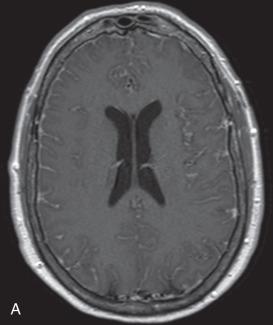
Specific neuroimaging patterns are encountered with fungi that are vasoinvasive of large caliber vessels at the base of the brain (circle of Willis), such as Mucorales species ( Fig. 23.2 ). While there may be variable associated meningeal inflammation in such cases, the primary neuroradiologic findings are vascular occlusion ( Fig. 23.2 ) and ischemic stroke of involved territories of brain parenchyma ( Fig. 23.3 ).
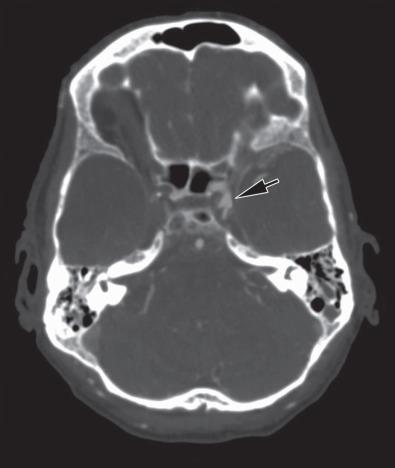
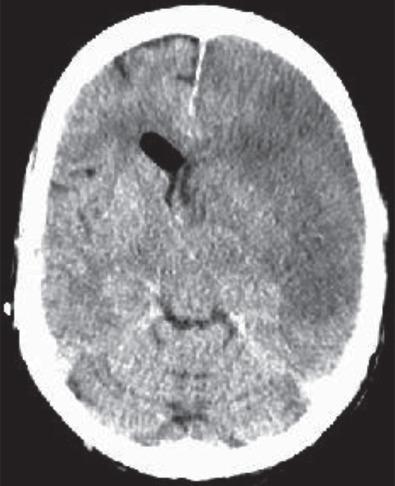
Gross neuropathologic findings parallel neuroimaging studies and vary greatly, depending on the organism responsible, the tempo of the infection, the immune status of the host, and the duration of infection antecedent to biopsy or autopsy. In patients who die soon after onset of symptoms in bacterial meningitis, the brain may show only severe edema and congestion ( Fig. 23.4 ). However, full brain and spinal cord examination may reveal considerable difference in thickness of the exudate for the same patient in different cerebrospinal fluid compartments, underscoring the value of full CNS autopsy ( Figs. 23.5 and 23.6 ). Dural venous sinuses should always be examined for thrombosis ( Fig. 23.7 ), and, if possible, full systemic autopsy should also be performed to assess not only the site of the primary infection but additional noncranial sites of infection, such as the lungs ( Fig. 23.8 ).
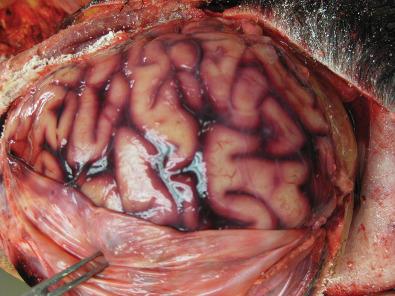
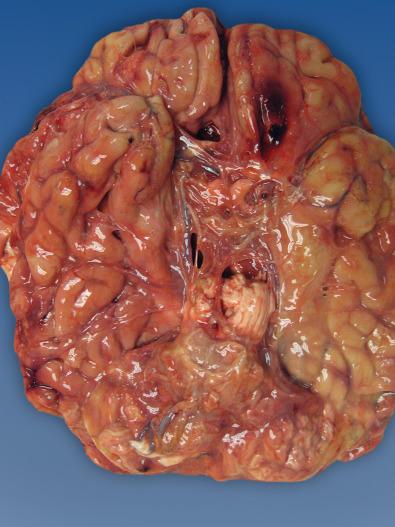
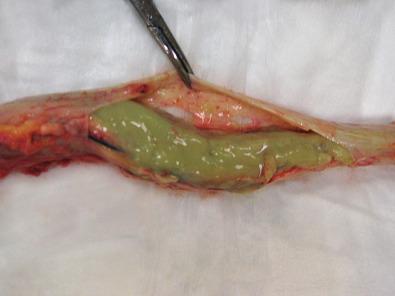
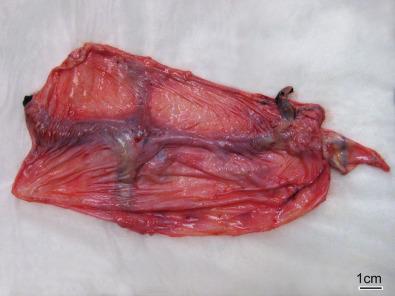
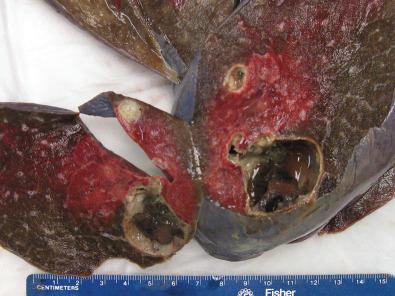
Petechial hemorrhage can be seen with meningococcal meningitis due to vascular injury. In neonates with bacterial meningitis, the only feature may be severe cerebral edema. A misconception is that basilar meningitis is confined to patients with fungal or tubercular meningitis, whereas in fact, it can occur in cases where the bacterial source of the infection is paranasal (i.e., more adjacent to basilar regions) or in partially treated bacterial meningitis ( Fig. 23.9 ).With longer severe disease, purulent, white ( Fig. 23.10 ), thick, even greenish (see Fig. 23.7 ) exudate within the subarachnoid space may obscure underlying architectural features in the brain or spinal cord.
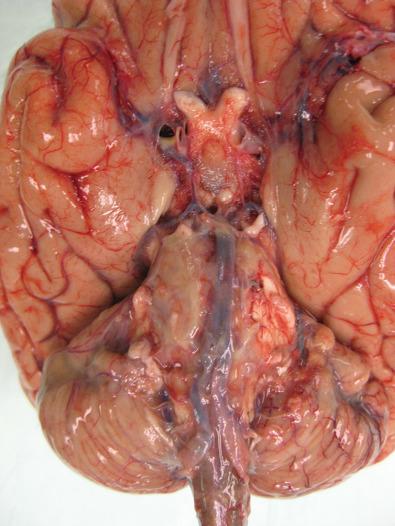
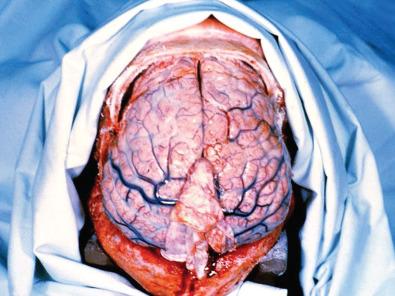
Late stages of bacterial meningitis can result in severe fibrosis of leptomeninges ( Fig. 23.11 ), hydrocephalus necessitating ventriculoperitoneal shunt, and periventricular extensive gliosis due to ventriculitis ( Fig. 23.12 ).
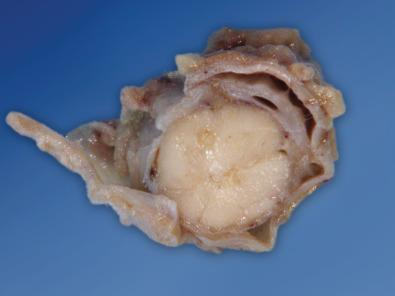
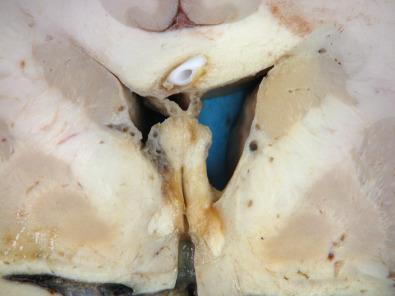
Tuberculous meningitis shows varying degrees of gelatinous exudate in basilar regions, but some are subtle. Viral meningitis typically shows no exudate, and mild hyperemia may be the only gross finding. The degree of meningeal exudate varies greatly in fungal infections and depends on the degree of the host's immune function.
Fig. 23.13 illustrates classic basilar purulent exudates due to C. immitis, whereas a host with meningitis due to H. capsulatum with far greater immune compromise shows only hyperemia with mild exudate over the basilar surface. Meningitis due to C. neoformans usually produces only glistening, subtle leptomeningeal opacification over the convexities of the brain. Opacification is caused not by the host inflammatory response, which is often completely absent, but rather by the abundant gelatinous capsular material of numerous fungal organisms present in the meninges. Coronal sections may be more striking, with cyst-like or “soap bubble” expansion of perivascular Virchow-Robin spaces ( Fig. 23.14 ), the latter being in continuity with the subarachnoid space, which is stuffed with encapsulated organisms. Fungal infections that are vasoinvasive of circle of Willis large caliber vessels at the base of the brain show intravascular thrombi, as in the case of Mucorales infection ( Fig. 23.15 ), with or without appreciable associated meningitis.
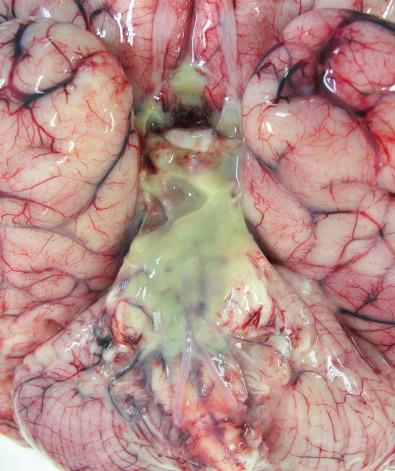
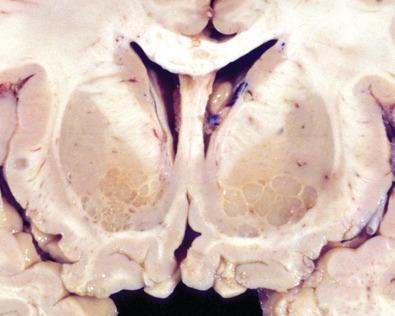
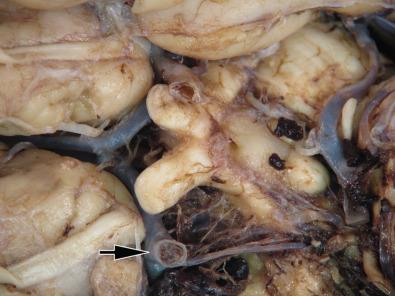
Acute bacterial meningitis is characterized by varying thicknesses of exudate overlying convexities, basilar meninges, and/or spinal cord; in the latter it is usually maximal in dorsal regions where the nerve roots may be completely encompassed ( Fig. 23.16 , arrows ). Microscopically, acute inflammatory cells surround leptomeningeal vessels ( Fig. 23.17 ) or may even secondarily cause vasculitis ( Fig. 23.18 ). The polymorphonuclear leukocytes (PMNs) influx may be intermixed with strands of eosinophilic proteinaceous exudate within the subarachnoid spaces (“protein threads”; Fig. 23.18 , arrows ). Considerable admixture of immature and mature PMNs may be present. Most hematogenously borne infections that cause bacterial meningitis (i.e., infections due to N. meningitides, S. pneumoniae, L. monocytogenes, H. influenzae, E. coli ) yield maximal exudate over the convexities of the brain during the acute phases of infection, whereas bacterial meningitis due to skull-based sources of infection (traumatic basilar skull fracture, otitis media, some paranasal and sinus infections) usually show purulent exudates over the base of the brain. Often, the neutrophilic collections sequester at depths of sulci rather than over crests of gyri. Considerable extension of the inflammation along Virchow-Robin spaces may occur, with gliosis in subpial areas of brain adjacent to the exudate. Additionally, there is often secondary vasculitis and nerve damage to neurovascular structures that are caught up in the inflammatory process. In N. meningitides meningitis, vascular endothelial damage can result in petechial hemorrhages in the meninges or cortical gray matter.
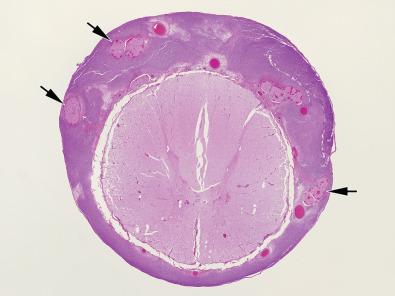
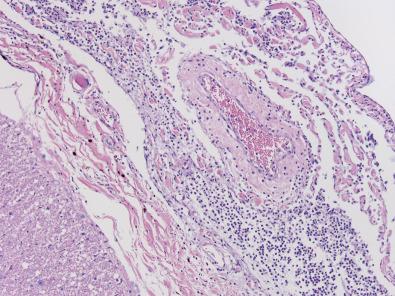
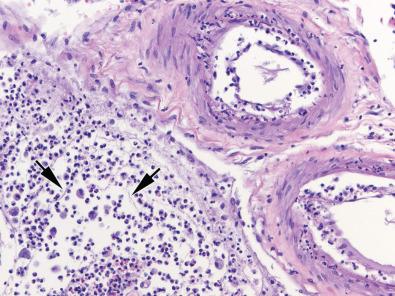
In overwhelming acute infections in which the host dies rather rapidly, such as in neonates, the amount of inflammatory exudate may be quite limited since the child can succumb to severe cerebral edema soon after onset of disease, before accumulation of PMNs. This correlates with the clinical features of neonatal meningitis in which the disease frequently occurs in the presence of normal CSF parameters. H. influenzae meningitis in young children similarly can be associated with little inflammation in early phases of the infection, corresponding to the clinical observation that normal CSF cell counts, chemistries, and Gram stain can be found in children with the disease.
Bacterial organisms can sometimes be difficult to identify in tissue, and except for the large filamentous bacteria or large bacilli ( Fig. 23.19 ), cannot usually be seen on routine hematoxylin-eosin (H & E) preparations. Paralleling the situation in the CSF for which Gram stain may be negative, Gram stain of tissue may or may not be positive in the subarachnoid space in cases of meningitis. Small gram-negative rods are notoriously difficult to identify. Especially when the patient received appropriate antibiotic therapy for a significant length of time before tissue examination, Gram stain may have no higher yield than prebiopsy, premortem bacterial cultures (positive in approximately 80% of cases), or CSF Gram stain (positive in approximately 60% of cases). Nothing substitutes for a meticulous and time-consuming search for organisms on special histochemical stains by the pathologist. Immunostains for specific bacterial organisms—that might otherwise obviate the need for the pathologist to search for the causal bacteria—are generally not available. Importantly, although a presumptive diagnosis of bacterial meningitis can often be made from the pattern of a neutrophilic exudate in subarachnoid spaces, the exact organism may be elusive. All tissue Gram stain results need to be correlated with premortem, intraoperative, or postmortem culture and PCR testing results.
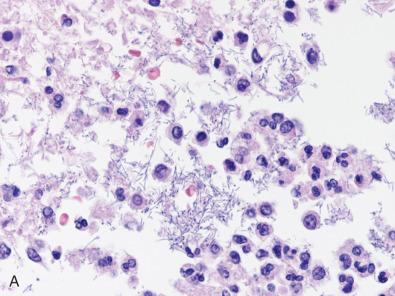
Subacute to chronic meningitis is characterized by progressive replacement of PMNs after the first few days of infection by mononuclear cells, including lymphocytes, plasma cells, and monocytes. Variable degrees of granulation tissue formation and meningeal fibrosis are seen as the process organizes over time, potentially blocking CSF drainage into basal cisterns and arachnoid granulations, leading to postmeningitic hydrocephalus. Inflammatory cells diminish in number over time with appropriate treatment, but have a tendency to persist in partially or ineffectively treated cases of meningitis.
Tuberculous meningitis can show significant numbers of subarachnoid PMNs in acutely ill hosts with overwhelming infection (e.g., neonates, young children, or immunocompromised hosts), but in most individuals, a chronic granulomatous meningeal infiltrate is found. Collections of epithelioid histiocytes, multinucleated giant cells, and caseating necrosis are classic; however, on examination of multiple regions of brain or spinal cord tissue in proven cases of tuberculous meningitis, these changes can be remarkably patchy in nature. Often, multiple microscopic fields are either devoid of significant meningeal inflammation or only nonspecific lymphocytes and mononuclear cells can be found. This has obvious practical implications for sampling error and the need for multimodal tissue testing (i.e., culture, PCR, and search for acid-fast organisms).
Chronic tuberculous meningitis, as well as several forms of more severe bacterial meningitis, such as those caused by S. pneumoniae or H. influenzae, can be associated with secondary vascular damage and secondary vasculitis, with resultant nerve or brain infarction in the acute, subacute, or chronic phases of the disease.
Syphilitic meningitis is characterized by mononuclear meningeal and perivascular infiltrates, neuronal loss and intense reactive astrocytosis in underlying cortex, and microglial influx, most often as single microglia aligned perpendicular to the pial surface (“rod cells”; Fig. 23.20A ). Plasma cells can be profuse in number ( Fig. 23.20B ). Necrosis due to vascular injury is less common but when it does occur, causing the so-called “gumma,” T. pallidum organisms may be numerous and are best identified by IHC ( Fig. 23.20C ), although silver stains (e.g., Steiner) may also work, albeit they are challenging to interpret in some cases. Pachymeningitis is a rare accompaniment of neurosyphilis and should be a diagnostic consideration in cases that otherwise might be interpreted as “idiopathic” hypertrophic pachymeningitis ( Fig. 23.20D ).
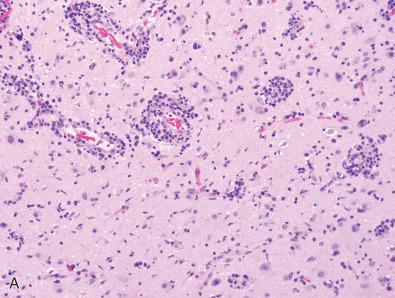
Viral meningitis differs considerably from bacterial meningitis in the often subtle degree of inflammation present in tissue sections. Classic features of viral meningitis are those of lymphocytic meningeal infiltrates ( Fig. 23.21 ) associated with perivascular lymphocytic extension along Virchow-Robin spaces. The microglial nodules and tissue destruction indicative of encephalitis are absent, by definition, and if identified, should suggest that the virus is producing an encephalitis in addition to the meningitis. Often the two conditions have overlapping features, and although clinicians recognize a predominance of one clinical presentation over the other for infections with certain types of viruses ( Table 23.5 ), at the tissue level, the division between meningitis and encephalitis may be less distinct.
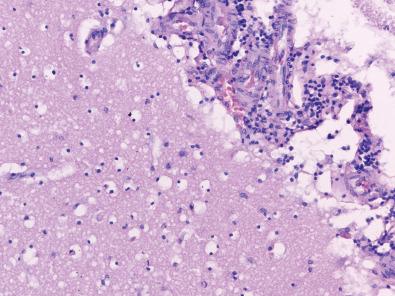
| Meningitis More Frequent Than Encephalitis | Encephalitis More Frequent Than Meningitis |
|---|---|
| Echovirus | Powassan |
| Coxsackievirus | Eastern equine encephalitis |
| Venezuelan encephalitis | Western equine encephalitis |
| Lymphocytic choriomeningitis (LCMV) | California (La Crosse) encephalitis |
| Mumps virus | VZV, CMV, HHV-6, adenovirus, rabies virus |
| HSV-2 | HSV-1 |
| Human immunodeficiency virus (HIV) | West Nile virus (although both occur) |
The subtle and minimal nature of the meningeal inflammation in some cases of bona fide viral meningitis cannot be overemphasized. Patients who succumb acutely may have little more than hyperemia, congestion, and brain edema, with correspondingly subtle histopathologic features. Lymphocytes and monocytes in the meninges may be few and far between. A high degree of clinical suspicion, coupled with extensive sampling to include multiple meningeal sections, may be necessary to even suggest the correct diagnosis of viral meningitis at all. At the other end of the spectrum, some cases of viral meningitis in their acute phases manifest with a CSF profile that includes considerable numbers of PMNs, such as lymphocytic choriomeningitis virus (LCMV) and WNV encephalitis, and in these instances, neutrophils are also found in the meninges by the pathologist.
Fungal meningitides exhibit an inflammatory cell population characterized by mononuclear and variably granulomatous response; the histologic features overlap with those seen in tuberculous meningitis. Fungal and parasitic meningitis offers the pathologist the greatest opportunity for identification of the causative organism, which is visible even on H & E stain due to the large size. Fungi may be seen in leptomeninges, either as free organisms or within multinucleated giant cells, as is often the case with Coccidioidomycosis infection ( Fig. 23.22 ). The meninges may contain extensive inflammatory infiltrates or, in the case of hosts that are severely immunocompromised, may consist of profuse numbers of fungi with little or no associated host inflammatory response. The latter was often seen in the pretreatment era of AIDS in patients with C. neoformans meningitis. An emerging form of cryptococcal infection has occurred in the U.S. Pacific Northwest since 2004 due to C. gattii, which may cause pneumonia, meningitis, or localized infections (cryptococcomas) in lung or brain.
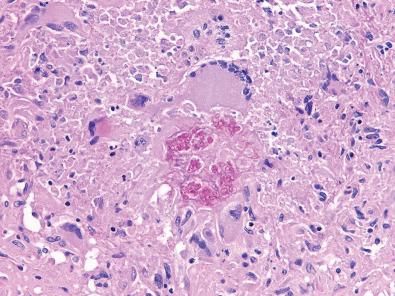
In patients who are treated for fungal infections such as C. neoformans, the organism may be engulfed by macrophages ( Fig. 23.23A ). Although fungi can be seen on H & E, additional periodic acid–Schiff (PAS; Fig. 23.23B ), mucicarmine, and Grocott methenamine silver (GMS) ( Fig. 23.23C ) stains usually better highlight yeast morphology and allow the pathologist to categorize it as a yeast, hyphal form, or spherule. In well-fixed specimens, the nucleus of Blastomyces dermatitidis can be visualized and aids in identification, as does the large size and broad-based budding ( Fig. 23.23D ). Of note, in treated cases of cryptococcal infection where organisms are engulfed by macrophages, mucicarmine staining of the capsule may be lost; this should not alter diagnosis ( Fig. 23.24A ). Knowledge of the size of the organism coupled with appreciation of the epidemiology of a particular geographic region aids in further narrowing the diagnosis, but ultimately, culture is the definitive gold standard for fungal species identification.
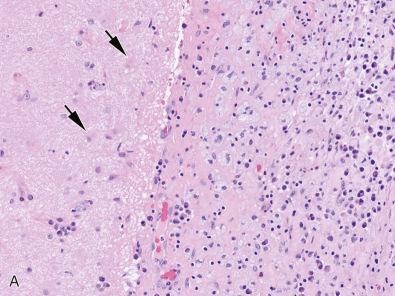
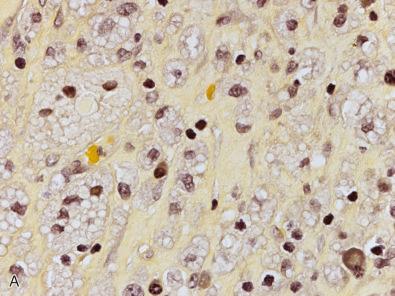
Whether a specific fungus is most apt to present as a meningitis versus a focal brain infection (necrotizing granuloma, often with multinucleated giant cells) depends to a great extent on whether it is a yeast versus mold or hyphal form and whether infection occurs in an immunocompetent or immunocompromised host. Neuroinvasive mold infections are rare in fully immunocompetent individuals, while yeast forms such as C. immitis or C. neoformans gattii may cause disease in immunocompetent patients due to environmental/geographic exposure, although certainly those with underlying immunosuppressive conditions often suffer more severe disease. One of the consequences of fungal as well as of tuberculous meningitis may be the development of secondary vasculitis and cerebral infarction. Mucorales , as well as occasionally other hyphal fungi such as Aspergillus , cause vascular thrombosis and organisms may be virtually confined to the blood vessel lumen or wall ( Fig. 23.24B ).
Clinically, most of the conditions that mimic acute bacterial meningitis can be differentiated by the clinical pathologist by CSF PCR studies or at the tissue level, in the uncommon event of biopsy or autopsy. Viral meningitis can clinically mimic bacterial meningitis, but the correct diagnosis is determined by the typical CSF profile and absence of PMNs in the CSF or upon histopathologic examination.
Rickettsial infections such as Rocky Mountain spotted fever and ehrlichiosis (both bacterial infections transmitted by tick bites) can rarely mimic more conventional types of acute bacterial meningitis, but usually are associated with skin rashes. Noninfectious CNS meningeal processes, including subarachnoid hemorrhage, chemical meningitis due to ruptured cysts such as epidermoid cyst or craniopharyngioma, or drug-induced hypersensitivity reactions, can clinically mimic acute bacterial meningitis, but are usually distinguishable by MRI findings and CSF profile, seldom requiring tissue biopsy or autopsy for diagnosis.
On occasion, subacute meningitis due to M. tuberculosis, fungi, or T. pallidum can be more fulminant and show overlapping clinical features with acute bacterial meningitis; correct diagnosis usually rests on appropriate CSF testing, and tissue-based identification is seldom required. Subacute to chronic bacterial meningitis can be much more difficult for the clinician to distinguish from noninfectious conditions, and these are more likely to generate CSF cytology specimens or, in indeterminate cases, require tissue biopsy.
Neoplastic meningitis, also termed leptomeningeal carcinomatosis (or lymphomatosis, melanomatosis, gliomatosis, etc.), consists of tumor cells diffusely infiltrating the subarachnoid space, causing clinical symptoms and neuroimaging signs that mimic subacute to chronic infectious meningitis. Tumor origin may be carcinoma, lymphoma, melanoma, sarcoma, or even a CNS primary, such as a glioma or embryonal neoplasm. Diagnosis is made by CSF cytology, and the yield correlates with volume of removed fluid, number of CSF samples assessed, sample transit time, and experience of the reviewer.
Testing for possible lymphomatous meningeal infiltrates usually requires ancillary flow cytometry testing of CSF and gene rearrangement studies to assess for clonality. CSF PCR testing for Epstein-Barr virus (EBV) is useful only for CNS lymphomas that are likely to be mediated by EBV, such as those in immunocompromised hosts.
The key initial diagnostic test for meningitis of any type is lumbar puncture, with accompanying assessment of CSF cell count, glucose, and protein. Initial testing for suspected meningitis cases should include routine cultures of blood and CSF, Gram stain of CSF, or PCR-based testing for organism identification. Since bacterial meningitis is a medical emergency, blood cultures are usually obtained immediately and antibiotic therapy is empirically started prior to speciation. For clinical pathologists, it is important to note that antibiotic therapy given to a patient a few hours prior to a lumbar puncture usually does not alter the CSF count, glucose concentration, Gram stain result, or PCR result.
Bacterial antigen tests (e.g., latex agglutination) are of low sensitivity, but may be useful in culture-negative cases such as patients who have undergone previous antibiotic therapy. Specifically, latex agglutination tests can detect antigens from S. pneumoniae, N. meningitides, H. influenzae type b, group B streptococcus, and Escherichia coli K1 strains, but they are being replaced by PCR testing. A multiplex PCR array will soon be available clinically and will provide rapid identification from direct CSF samples and evaluate for multiple organisms including common causes of bacterial and viral meningitis.
For viral meningitis, PCR-based testing of CSF or serum, or CSF serology is often necessary to document the specific viral cause. The overwhelming majority (>75%) of viral meningitis cases are due to enteroviruses.
In most individuals with tuberculous meningitis, a chronic granulomatous meningeal infiltrate is found, and collections of epithelioid histiocytes, multinucleated giant cells, and caseating necrosis are classic (see Fig. 23.19B ); however, these changes can be remarkably patchy and some microscopic fields are either devoid of significant meningeal inflammation or show only nonspecific lymphocytes and mononuclear cells can be found. This has obvious practical implications for sampling error and the need for multimodal tissue testing (i.e., culture, PCR, and search for acid-fast organisms). Organisms are not visible on H & E and require Ziehl-Neelsen histochemical staining ( Fig. 23.19C ). Tuberculous meningitis, as well as several forms of more severe bacterial meningitis, such as those caused by S. pneumoniae or H. influenzae, can be associated with secondary vascular damage and secondary vasculitis ( Fig. 23.19D ), with resultant nerve or brain infarction in the acute, subacute, or chronic phases of the disease. A high clinical index of suspicion often guides management for tuberculous meningitis.
The diagnosis of fungal meningitis is aided by polysaccharide antigen tests used for cryptococcal and histoplasmal meningitis since fungal culture is often unrevealing. Eosinophils in CSF may be seen with fungal meningitis due to C. immitis. Newer testing methods are being developed but are not available to all. Examples include DNA sequencing, MALDI-TOF proteomic approaches, detection of GM (a polysaccharide of the outer cell wall layer of Aspergillus in patients with suspected aspergillosis), and assessment of 1-3-beta- d -glucan for Aspergillus.
The diagnosis of syphilitic meningitis is made when a reactive serum treponemal test (fluorescent treponemal antibody absorption [FTA-ABS]) is associated with a typical CSF profile of lymphocytic or mononuclear pleocytosis and an elevated protein or when a CSF VDRL is positive.
Become a Clinical Tree membership for Full access and enjoy Unlimited articles
If you are a member. Log in here